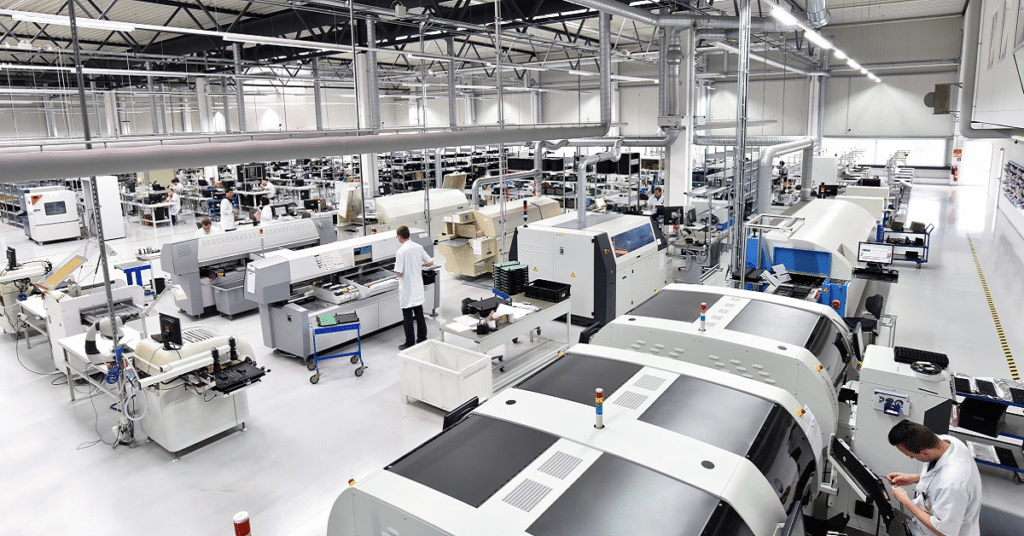Manufaktur elektronik telah mengalami kemajuan signifikan dalam hal otomatisasi, namun industri ini belum mencapai otomatisasi sepenuhnya. Beberapa faktor berkontribusi terhadap keterbatasan ini, mulai dari kendala teknologi hingga pertimbangan ekonomi. Artikel ini mengkaji alasan utama mengapa manufaktur elektronik masih sebagian diotomatisasi dan mengeksplorasi upaya yang sedang berlangsung untuk mengatasi tantangan ini.

Kendala Teknologi
Salah satu alasan utama terjadinya otomatisasi parsial di manufaktur elektronik adalah keterbatasan teknologi peralatan saat ini. Komponen tertentu, terutama komponen lubang tembus, menghadirkan tantangan bagi sistem otomatis:
- Komponen Lubang Tembus: Tidak seperti komponen pemasangan permukaan, komponen lubang tembus memiliki kabel yang melewati PCB. Mesin SMT terutama dirancang untuk komponen pemasangan di permukaan dan tidak dapat sepenuhnya menangani komponen melalui lubang. Meskipun ada mesin yang mampu memproses komponen melalui lubang, mesin tersebut belum secanggih atau tersebar luas seperti mesin SMT.
Kebutuhan akan Fleksibilitas
Perkembangan produk elektronik yang cepat menuntut fleksibilitas dalam jalur produksi, yang mempersulit upaya menuju otomatisasi penuh:
- Perubahan Teknologi yang Cepat: Teknologi elektronik berkembang dengan cepat, sehingga lini produksi harus dapat beradaptasi dengan produk dan desain baru. Kemampuan beradaptasi ini sering kali melibatkan penyesuaian dan konfigurasi ulang manual yang sulit diotomatisasi sepenuhnya.
- Restrukturisasi Lini Produksi: Banyak pabrik perlu sering memodifikasi lini produksi mereka untuk mengakomodasi berbagai jenis produk. Fleksibilitas ini sulit dicapai dengan sistem yang sepenuhnya otomatis, yang sering kali dioptimalkan untuk tugas dan konfigurasi tertentu.
Pertimbangan Ekonomi
Faktor ekonomi juga memainkan peran penting dalam tingkat otomatisasi dalam manufaktur elektronik:
- Biaya tenaga kerja: Di wilayah dengan biaya tenaga kerja rendah, seperti banyak negara Asia, insentif ekonomi untuk berinvestasi dalam otomatisasi penuh lebih rendah. Tenaga kerja manual tetap hemat biaya dibandingkan dengan investasi awal yang tinggi yang diperlukan untuk teknologi otomatisasi canggih.
- Meningkatnya Biaya di Asia: Meskipun biaya tenaga kerja di negara-negara seperti China meningkat, otomatisasi semakin dipertimbangkan sebagai sarana untuk mengurangi biaya jangka panjang dan meningkatkan efisiensi produksi.
Tabel: Faktor-Faktor Utama yang Mempengaruhi Otomatisasi Penuh dalam Manufaktur Elektronik
| Faktor | Keterangan |
|---|---|
| Kendala Teknologi | Mesin SMT saat ini mengalami kendala dengan komponen tembus lubang, sehingga membatasi kemampuan otomatisasi. |
| Kebutuhan akan Fleksibilitas | Kemajuan teknologi yang pesat dan seringnya perubahan lini produksi menantang otomatisasi penuh. |
| Pertimbangan Ekonomi | Biaya tenaga kerja yang rendah di beberapa wilayah mengurangi urgensi otomatisasi; meningkatnya biaya mengalihkan fokus. |
Kesimpulan
Perjalanan menuju manufaktur elektronik yang sepenuhnya otomatis masih berlangsung, terhambat oleh faktor teknologi, fleksibilitas, dan ekonomi. Meskipun kemajuan signifikan telah dicapai, terutama dalam otomatisasi proses pemasangan permukaan, tantangan tetap ada dalam mengintegrasikan sistem yang sepenuhnya otomatis yang mampu menangani berbagai persyaratan produk yang terus berkembang. Mengatasi tantangan ini memerlukan inovasi yang berkelanjutan, investasi dalam teknologi canggih, dan penyesuaian strategis untuk menyeimbangkan otomatisasi dengan realitas ekonomi.
Memahami batasan ini membantu produsen menavigasi kompleksitas produksi modern dan merencanakan secara efektif kemajuan teknologi otomasi di masa mendatang.
